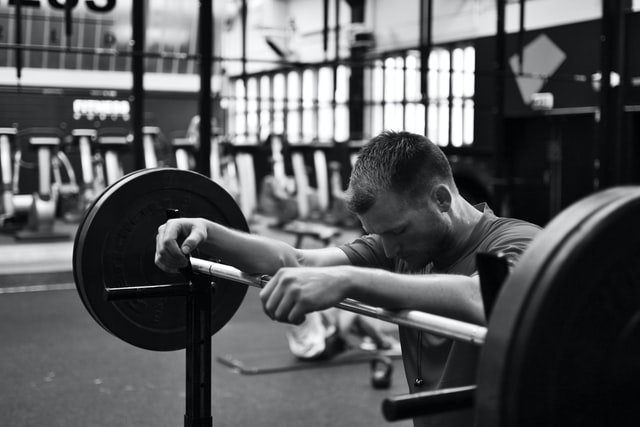The 4 training schedules
This post describes and analyzes the 4 strength training schedules based on the variation in intensity and volume throughout the training cycle.
In this series of articles we deal with some of the most important concepts of strength training, collecting notes from the recently published book Strength, Speed and Physical and Sports Performance written by renowned researchers Juan José González Badillo and Juan Ribas Serna.
Summary
- Introduction of the four training programs: stable intensity (PIE), progressive intensity (PIP), mixed progressive intensity (PIPM) and accentuated oscillations (PAO).
- The PIE is the most suitable if the subjects are little or no trained or if they are very young or both.
- PIP is the most common and useful for most subjects.
- The PIPM is a programming that should be applied only to subjects with medium or high strength needs, who have worked with the previous programming and with experience in strength training.
- PAO is probably only necessary in the case of subjects with very high maximal strength needs and with a lot of training experience.
Evolution of loads through a training cycle
It seems that both the overload and the variation of the load are positive to maintain the improvement of strength and sports performance for a long time. A problem that is further from the solution is how to carry out the manipulation of volume and intensity to provide adequate progression and variation of loads. The results of the studies that have addressed this issue do not allow for the time being to reach definitive conclusions.
The current solution is in a suitable mixture of the contributions of the science and of the “art” and common sense of the trainer. This entry describes the basic alternatives that can be used, adding explanatory comments on the possibilities of use.

Programming of a progressive increase in absolute intensity with stable volume and relative intensity.
This model can be called “stable intensity programming” (SIP), and would correspond to what has already been commented regarding “non-periodized training”, because, apparently, there is no “variation” in the load of training. The intensity is stable or even in regression in relative terms, the volume practically stable and the absolute load (weight) in progression.
This model is characterized by maintaining the same training format throughout the cycle. If you train to failure, you choose a number of maximum repetitions per set, say six, which corresponds to a relative intensity of 6RM, and you do three sets. We would thus have a training with a relative intensity and a permanent volume, in this case 3x6RM, which is performed with a determined resistance (weight), which represents the absolute intensity.
When the subject is capable of performing more than 6 repetitions per series, the resistance is increased, so that the relative intensity is maintained and the absolute intensity is increased.
The figure shows the schematic evolution of volume and absolute and relative intensity.

(PIE). The volume and relative intensity are theoretically stable. The absolute intensity (weight) used should increase progressively throughout the cycle.
But this model, as described, should never be used, since it is based and controlled, as usual, on training to muscle failure. However, this model, without failing, would be applicable especially to beginners but also to any athlete for as long as it produces a positive effect.
The PIE model, as described, should never be used, as it is based and controlled on training to failure. It should be applied without ruling.
Because this model is the Ideal: each time you can move more absolute load representing the same relative intensity, the same effort or degree of fatigue, and even in the most favorable cases, representing an increasingly lower relative intensity.
This means that performance is permanently improved. If the relative intensity is controlled through the speed of execution, the number of repetitions per programmed series must represent a non-maximum effort character, being able to choose the one that is considered most appropriate, although a moderate or low one would be the most recommendable. If the loss of speed in the series is added to the control of the speed of the first repetition of the series, the control of the training load would be the most complete and, with high probability, the most precise.
Among other reasons, because if the loss of speed in the series is controlled, the number of repetitions is not programmed, since this would mean training with the same relative intensity, but with different degree of effort, due to the differences in the number of repetitions before the same relative load that each person can perform (González-Badillo et al., 2017).
In this way, the trainer can make mistakes in the choice of speeds and in the losses of serial speed, but will have available the necessary information to know what training is being done and is responsible for the results obtained, which will allow him to take decisions based on the analysis of the relationship between the load and its effects, which is the only way to improve the training methodology itself.
Once a relative intensity has been chosen, preferably through the speed of the first repetition of the series, the athlete will maintain the absolute load that represents it until the speed of the first repetition is 7-9 hundredths of a meter per second higher than the reached in the first session with said absolute load. At this time, the absolute load should be increased to the extent necessary for the speed to return to the programmed speed.

In this way, the relative intensity throughout the cycle will be very stable, but it will oscillate from the programmed level to a lower level of approximately 5%, which is what decreases when the speed increases by 7-9 hundredths of a meter per second, according to the exercise in question. The volume will stay the same with the same repetitions per set or it will fluctuate in a range of about two repetitions per set.
Although this will be discussed later, the relative maximum intensities in this type of training will be the lowest in sports life. This training programming scheme would be ideal if it could be applied at all times, throughout sports life. But as performance increases, intensity stability, whatever it may be, may no longer be useful, since, on the one hand, lower intensities will not suffice, and on the other hand, medium and high intensities cannot be matched. / should be used from the first session nor can they be maintained constantly over time.
Therefore, within this scheme, it is possible to program progressive intensities, not totally stable, within the cycle, but in a very small range, such as, for example, from 45 to 60% of the estimated initial RM. Once these relative intensities have been chosen, the absolute loads corresponding to each percentage would be programmed, and when the time comes to increase the weight, if the speed of execution tells us that the intensity represented by the new weight is below the programmed relative intensity , the new weight will be maintained, without increasing it to equal the expected relative intensity, even if the relative intensity remains stable or even in regression, and below the programmed one.
It will pass, or will be, in the following programming model when the subject needs a relative intensity to improve their performance equal to or greater than the real 70-75% of the RM.
Programming of a progressive increase in intensity and a progressive reduction in volume
This model can be referred to as “stepping intensity programming” (PIP). What has come to be called “periodized training”. This can be considered as the classic form of training variation. As its own name indicates, it basically consists of progressively increasing the intensity during the training cycle while reducing the volume, although in the first two-four weeks there can be an increase in both volume and intensity.
The progressive increase in intensity does not mean that each session has to increase it, and this would be practically impossible unless the cycle was extremely short. In the same way that the volume or the number of repetitions per series is not permanently reduced.
The base of this type of programming is in the increase of intensity, since the reduction of the repetitions by series is a logical consequence of the increase of the intensity.
The use of this programming scheme should be governed by the same control procedure as the previous one. Therefore, it should be dosed and controlled by speed of the first repetition and by the loss of speed in the series. The difference with respect to the previous scheme will be especially in the values of the speed of the first repetition, which will tend to decrease progressively as the cycle progresses (tendency to greater relative intensity). The specific relative intensity values will be seen in later sections, but we will never reach the character of maximum effort (muscular failure).
This model would be applicable to subjects who have passed the previous stage and have manifested stagnation. It is valid for all strength needs. The differences between the groups with different strength needs will be in the relative loads, which will tend to increase the greater the strength need, and somewhat in the speed losses in the series (the degree of fatigue) which will also tend to increase slightly. s strength needs are greater.

Schematic evolution of intensity and volume in PIP.
Programming of a progressive increase in intensity and a progressive reduction in repetitions per series with load oscillations.
This model can be referred to as “mixed progressive intensity programming (PIPM)”. This scheme would also be associated with what is understood by “periodized training”, but with oscillation of the maximum relative intensities. This type of programming would have the same characteristics as the previous one, except that the alternative reduction and elevation of the maximum relative intensity is admitted at certain moments of the cycle.
Until the relative intensity does not reach an effort equivalent to 80-85% of the RM, the intensity will vary in the same way as in the previous model. From here, high intensities will alternate with smaller ones. The need to alternate intensities occurs mainly for two reasons: the increase in the frequency of training the same exercise to three times a week and the increase in the maximum intensity reached, which is so high that a recovery is necessary, between sessions.
Until the relative intensity does not reach an effort equivalent to 80-85% of the RM, the intensity will vary in the same way as in the previous model. From here, high intensities will alternate with other smaller ones
It could also be justified by the need to smooth the progression of intensity. For example, it would probably be too stressful to have to do an effort equivalent to 85% of the 1RM for the first time in the cycle three times in a row in the same week, so using 75 or 80% in any of the sessions could better adjust to the current capacity of the subject and achieve a better adaptation.
Therefore, this way of programming is fundamentally progressive, but it is also slightly “wavy” or “undulating” between sessions. The dosage and load control should be done following the same procedure as in the previous schemes, and without considering the possibility of muscle failure.

Schematic evolution of intensity and volume in the PIPM.
The use of this scheme should occur in very few cases, since on few occasions the same exercise should be done three times a week. Except in the specialty of weightlifting, it will practically never be necessary to use the same exercise three times a week.
It would be applicable only to subjects who have passed the previous stages, have manifested stagnation, have to increase the frequency of training and exercises, and have high strength needs.
Programming of a progressive increase in intensity and a progressive reduction in repetitions per series, but with accentuated oscillations in volume and intensity
Let’s call this pattern “sharp oscillation (PAO) scheduling”. This scheduling model is characterized by a sharp oscillation of volume and intensity every two weeks or so. Increasing the intensity every two weeks approximately. The increase in intensity is very rapid from the first weeks. Two weeks —generally— of high volume and lower intensity are alternated with two weeks of higher intensity and volume, and the process is repeated until the cycle is complete.
Despite these oscillations, the volume values tend to decrease as the cycle progresses, while the intensity tends to rise. It is argued that short bouts of high volume stimulating hypertrophy, alternated with short phases of neural stimulation (although neural stimulation is always present) may offer greater strength gains than continuous intensity progression models.
Probably this model is not necessary to apply it in any case. The load values, especially high volume and “hypertrophy” training until muscle failure, are not applicable to any sports specialty, as they do not provide better performance than lower loads before the same training exercise (Folland, e 2002; Izquierdo, Ibáñez et al., 2006: Sampson 4 Groeller, 2016; Drinkwater, et al., 2 Willardson, et al., 2008; Pareja-Blanco et al., 2016) nor on other untrained exercises (Pareja-Blanco et al., 2016).

Schematic evolution of volume and intensity in PAO.
As indicated, this model probably does not need to be applied in any case. If it were to be applied, it would be with subjects who have passed the previous stages, have manifested stagnation, have to increase the training frequency of some exercises and have very high strength needs.
Some of the works in which the effects of models with structures similar to those described have been studied, find that some are more effective in improving strength, while others conclude that there are no significant differences between the results obtained. However, it must be taken into account that the models that we have described are not applicable as alternatives at the same time for the same subjects, but as models that can be applied progressively as progress is made in the development of strength and level of performance. .
In the studies that appear below, they are not understood in this way, but as models with structures similar to ours that are applied at any time. In addition, it must be taken into account that the training sessions in these studies are practically always to failure, which should not be recommended at any time in sports life. Despite all these nuances, it is convenient to have an idea of how the behavior of these models could be with subjects at different levels of training.
Baker et al., (1994) found no significant differences in 1RM squat and bench press, vertical jump, and body composition (fat-free muscle mass) between three groups that performed programming equivalent to one PIP/PIPM, one PAO and a PIE; equalizing volume and intensity. It seems, therefore, that by equalizing the volumes and intensity, no differences are found between different forms of the program.
It seems that by equalizing the volumes and intensity, no differences are found between different forms of the program.
Herrick & Stone (1996) used a PIP type of training that ranged from 3×10 to 3x2RM, and another of the PIE type of 3x6RM for 15 weeks. It is concluded that there were no significant differences in the strength gains between groups, but there did appear a tendency to produce a stabilization of the improvement at 15 weeks in the PIE type group, and the percentages of improvements, although not significantly. Significantly, they were higher in the PIP group. Volume is considered to have a greater effect than manipulation of reps per set and sets.
Bradley-Popovich, (2001) maintains that there are no reasons to consider that PAO programming is superior to the classical model (PIP/PIPM). However, Haff (2001) considers that the incorporation of intensity fluctuations could prevent fatigue and its negative effects on technique and injury prevention. In two reviews carried out by Fleck (1999, 2002) the conclusion is reached that despite the few studies carried out on this problem, PIP and PIPM programming offer better results in strength and power than PIE with a and multiple series.
The greatest strength gain may be related to the changes in training volume (volume reduction at the end of the cycle) that occurs in the PIP and PIPM. when talking about the comparison of the different programming models (“periodized and non-periodized”).
incorporating fluctuations in intensity could prevent fatigue and its negative effects on technique and injury prevention
In summary, although in these specific studies it seems that the PIP type programming and, above all, the PIPM type are the most appropriate to manipulate the volume and intensity if it is intended to improve strength in training periods that last up to 16 weeks Some issues should be taken into account.
A schedule of 16 weeks is too long a period of training time, so it is hardly applicable. The use, in many cases, of loads with different intensity and volumes does not allow an adequate comparison of the different models. Each of these basic types of programming has its most suitable application.
What training schedule to choose?
PIE is most appropriate if the subjects are poorly trained or untrained or very young or both, regardless of the degree of force development required by the subjects.
The results obtained in different studies by the authors suggest that to improve performance it is enough to maintain a certain degree of low effort stable, which in practice could be as low as the equivalent of 30-50% of the RM, for a period of time. from 6 to 12 months as long as the absolute load is gradually increased.
To improve performance, it is enough to maintain a certain degree of low effort stable, which in practice could be as low as the equivalent of 30-50% of RM, for a period of 6 to 12 months as long as the absolute load goes away. gradually increasing.
PIP is the most common and useful for most subjects. It should be applied to somewhat trained subjects with medium or high strength needs and who have already passed the previous stage, and to experienced subjects who have low or medium strength needs. Depending on the strength needs, the load will be increased to a greater or lesser extent.
The PIPM is a programming that should be applied only to subjects with medium or high strength needs, who have worked with the previous programming and, therefore, with experience in strength training, although it is considered that it would only be necessary in a few cases.
PAO is probably not necessary in any case, but if it is applied, it is only necessary in the case of subjects with very high maximal strength needs and with a lot of training experience.





